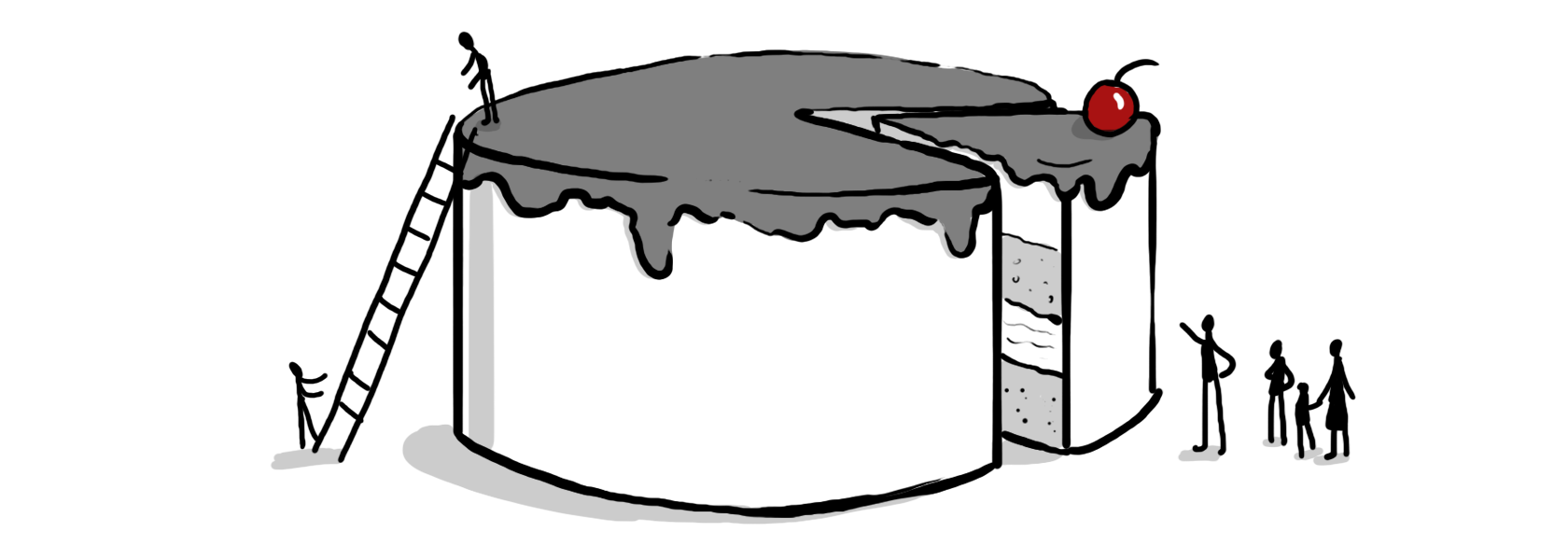
Transformation hurts
a brand new approach to business analysis

In this fast paced modern world, many businesses, companies or products, when facing the need for transformation, face hard challenges. Even when you actually see the target, which is often not the case, it is still very hard to find the right path.

Business owners, Product owners can find it hard to really picture the way they want their business or product to evolve. And while there are plenty of tools available like OPM, BPM, BPDM, BPMN and others, now they seem outdated, incomplete. They struggle to visualize the whole picture of the current reality or the end result.
In this article I am providing a tool that can help break things down to pieces and describe them to show the whole business picture. This tool can help you to see the pieces that need to be changed first clearly, help you chose the direction you want to go and the way to get where you want.
In this article I am providing a tool that can help break things down to pieces and describe them to show the whole business picture. This tool can help you to see the pieces that need to be changed first clearly, help you chose the direction you want to go and the way to get where you want.

And the concept is not that hard. There is no need to write a book about it. Just bear with me for the next couple of pages, I promise it will be worth it in the end.
Where Idea Comes From

So the basic idea is actually coming from Atomic design.
It is a simple (yet still complex to accomplish) idea of breaking down the system down to components and build from there. Each system and its interface is built from pages, pages built with templates, that in turn have organisms that are built from molecules which consist of atoms.
It is a simple (yet still complex to accomplish) idea of breaking down the system down to components and build from there. Each system and its interface is built from pages, pages built with templates, that in turn have organisms that are built from molecules which consist of atoms.

Atomic design approach allows you to build a set of rules for any system to work consistently. At each layer you have objects and rules by which they are working together to form more complex objects up to the top. It allows you to change any atom type in the system, for example, and it will be replaced everywhere where it is used across the whole system. Pretty good, right?
Let us look at this perfect picture once more.
Let us look at this perfect picture once more.
- We have layers of objects
- Objects on each layer do not repeat themselves and have their own purpose, you will never have Button on one layer and Bigger Button on another.
- On one layer there can be objects of different complexity
- Each layer have it's own set of rules that binds objects of one layer to form object of another.
- There are also distinctive rules on how to add a new object.
- Changes on each layer will never break any other layers of the system if they follow the rules.
- When introducing a massive change you can simply replace whole object and even change rules as long as you do not break dependencies and your new components do not mix with old. No mix of the rules.
This gave me an idea. Just like software interface, business consists of layers. You can have general vision, strategic, finance, growth, business, organizational, implementation, auxiliary, support, people and many other levels, each with its own set of rules, targets, processes and units. That is how the general idea was born. But before we get any deeper, let us look at one example more .
Ways to describe an object

Let us do a little exercise together. Let's describe a human, me, for example. How hard can this be?
As a human, I'm one of the billions of people living on the planet of Earth. A society that has been built over millennia. I take part in population growth, and the Earth has a maximum capacity of humans. As humans we consume and produce natural resources. Consumption and production have their own rates.
Let's move layer down.
Let's move layer down.

As a human, I am a citizen of a country. My social status is determined and rules apply if I want to change it. My movement and personal capabilities are limited by the rules of politics between the countries. I have rules on how to get a job, relocate, travel, visit places. Rules apply to my family status, I am a part of the cell called "family", I'm married, I have children. All my relationships are described by rules that are described in plenty of various documents.
But let's not stick to this layer. It is vast, I even think that there are actually more layers here, but it is not important for the purpose of the example.
But let's not stick to this layer. It is vast, I even think that there are actually more layers here, but it is not important for the purpose of the example.

As a human, I have a body. My body is built with body parts. Each of my body parts has its own purpose, capabilities, limitations that operate on rules. Each body part can be described in details and forms of the description will be similar for each body part.

As a human, I am a combination of bones, tissues and organs. Each of them has their own function, definition of "working", and connection to other organs, tissues and bones. Connection is built on rules and so my body performs well only if those rules apply. If one of the rules is not working, my organizm requires a change, or it will stop working.
Let us go deeper.
Let us go deeper.

As a human. I am built from different materials. Each material has its own purpose, limitations and rules on how it works, how it is connected. Muscles, blood, bone tissue, skin, hair, nails, nerves. I have rules on how my neurons are connected to each other and how they transfer the signals, my muscles also have distinct rules on how they operate, their limitations and success criteria.

As a human, I'm a collection of molecules and elements. Each molecule can be categorized, described and have the rules for multiplication, life cycle, connection to other molecules. Each element has its purpose, distribution method, way to get more elements of this type. Without one of the elements I can not operate efficiently (or operate at all) without actually changing all bunch of rules.

As a human, I also consist of atoms. Each atom also have special rules on how it operates, states it can be in. General percentage of the specific atoms count in me is determined and changing it might result in malfunction or bad performance.

And let us stop it here. I think you have got the idea. Each of the descriptions here describes me as a human. Each of the descriptions is actually full and describes one of the aspects of my existence with set of rules that are applied only to objects from the layer. Now if I would be in this kind of research, if I had enough information in each of the layers, I could see what do I need to change exactly to operate more efficiently as a human. I can not change something only on one level. For each small change I might require to make changes on several or even all of the levels. And I will not jump here to examples, I'm sure you can bring many of your own. Changes in our life bring transformation to plenty of levels, starting from food, time, sports, job, family status, place of living or even citizenship.
Now let's apply all of this to the business. How do we describe a business, a product, a company the same way and what can we expect to see in the end.
Business application

Right now it is considered very modern to have values in the company, purpose, vision and strategy. Though it does not work everywhere, somewhere it works but does not help, and in some cases it does not affect anything but complicates things even more.
One of the very good examples was company I used to work. When the need for transformation was realized, our leadership started with the description of current reality and what they want it to be. We had Strategic layer with high level description of the company, who we are, what we do, and how we succeed. Then we had a business level describing areas of the business that company has, it's structure. And finally, Implementation level that described how we operate. It actually was a good effort and it helped to move company and achieve some transformation, but in result lack of both number of layers and details in them halted the transformation after some time.
One of the very good examples was company I used to work. When the need for transformation was realized, our leadership started with the description of current reality and what they want it to be. We had Strategic layer with high level description of the company, who we are, what we do, and how we succeed. Then we had a business level describing areas of the business that company has, it's structure. And finally, Implementation level that described how we operate. It actually was a good effort and it helped to move company and achieve some transformation, but in result lack of both number of layers and details in them halted the transformation after some time.

That is of course my own opinion and current employees of the company can debate with me on that, I'm always open. The problem, as I see it, was that many of the key aspects of company operation was left undescribed, left out.
Not even in a form of vision of what we are trying to achieve. Also, lack of KPI's connected to most of the described processes led to big uncertainty. But still what we had, helped company to make a big leap in transformation and increase in value of the business in short amount of time.
When describing your own company or product, you can go two ways. You can describe current reality to see where you need to apply resources and efforts to make changes most needed, or you can describe a desired future state to align your strategy and transformation decisions. What you definitely need, is to make sure that you find every layer that it has. You can choose as many or as few layers to start with. But remember to add more layers as you go through the change. If transformation is slowed down or if it does not bring you the effect you wanted - you've missed an entire layer somewhere.
Not even in a form of vision of what we are trying to achieve. Also, lack of KPI's connected to most of the described processes led to big uncertainty. But still what we had, helped company to make a big leap in transformation and increase in value of the business in short amount of time.
When describing your own company or product, you can go two ways. You can describe current reality to see where you need to apply resources and efforts to make changes most needed, or you can describe a desired future state to align your strategy and transformation decisions. What you definitely need, is to make sure that you find every layer that it has. You can choose as many or as few layers to start with. But remember to add more layers as you go through the change. If transformation is slowed down or if it does not bring you the effect you wanted - you've missed an entire layer somewhere.
So where do we start? Start from the top level. Describe (or even better draw it on the wall) your business in general, what are its goals beside making money. What culture is in the company or what you want it to be. Focus on targets, you must know how you will succeed, or even more importantly, how do you know if you indeed have succeeded. Who we are, What we do and How do we succeed, are just few of good example questions to start with.

Next go deeper. Business level, as I mentioned above, is a good layer. Describe big parts of your company. Describe the rules on how they connect. Describe the way you want them to operate together if you are building a perfect state. It is important to specify for each of the elements on this layer - their purpose (it should be clear), their culture (how they connect to other parts) and, very important, how do you know they succeed in their operations. Choose KPI metric, not some random stuff, you must see clearly if the change is better or it is making it worse.

Next focus on Decision level. Describe what types of decisions are made in the company. You need to clearly see the connections. How one decision can affect the other. How decisions are made. Build rules or make rules to implement rules on the go. If you want to go Consent decision making path or Hierarchical is completely up to you. But in result you need to have a decision making rights map.

Next you can go to Implementation level. Hierarchical pyramid, matrix, flat, it does not matter which you prefer. Describe your working units, how they operate, how they are created, how they are disbanded. Describe rules for units communication. Here you can clearly see if the system you have is too complicated. For example having one unit that depends on many others will always lead to loss in performance. Here you have your organs, each with its own purpose, metrics and objectives. How organ connects to other organs. If you actually draw this one - it would be even better. You will clearly see the dependencies that complicate things.

But do not forget about your materials and tissues. Next layer. Describe horizontals you have in your business. Way for people to progress or move from one horizontal to another. How people get in, how people get out. What are the rules and where are the connections. Be prepared to come back to this layer often as there are plenty of border cases, especially if change is required here for some time now.

And, of course, next is the People level. Culture at the workplace. How do we communicate on personal level, how do we respect each other and most importantly what to do if rules are not followed. How we change the rules, how do we handle difficult situations.

Communication level is also important. Where does the information goes and where it is needed. Again better done in a form of a map, information flow can actually show you where to start your transformation. Usually performance is affected by bad information flow first. And remember, do not draw your cloud castles here, check every fact. If you think that someone should have the information, it does not mean he actually has it. And this is actually easy to check, simply ask.

You can add Resources layer with rules on how resources are distributed. Add a Logistics layer if you have geographical distribution of physical materials or assets.

Add more cultural levels if you have several cultures at different parts of the business. Look for more layers and start by simply writing them down. Accept that they are there and you need to look at them later.
Short summary of the approach:
- List your business layers starting from the top. Remember, you will not get it completely the first time anyway. You will need to come back to the list after your first struggle.
- Each layer is designed to bring different perspective on the company or the product. If you have layers that repeat themselves in purpose and object types (for example same objects but bigger in size) - you need to combine layers, or something is wrong with the layers, or it is the problem that needs to be solved
- Each layer should be independent of another. Rules of the layer are applied only to objects on that layer
- Briefly describe each layer and what it represents. Try and get clear overall picture first.
- Start adding more details to each layers and continue until you have your clear transformation goals or even plans
- Add KPI's everywhere where you can. If you can not - that is first sign of a weak spot
- If it getting to hard to describe - this is your transformation spot, try and form a vision for this exact part, look at ways to get your company there.
- Remember: You can not introduce changes only at one level. Body of your business will reject this kind of transformation. When introducing a change - see what layers it will affect.
- If transformation goes not according to plan - do not blame transformation, find out what you have been missing and start transformation from this spot
- Remember how we described the human above? Try to do the same for the business.
What you get in the end

The idea is to look at your business at different angles. Each layer is an independent set of rules that provide you with insights on how your business operates depending on perspective.
Even if you simply stated your layers and briefly described them you can begin to see where it seems wrong. Going deeper in each of the layers you can clearly see the growth points, what can be improved and what must be improved. When you have difficulties describing one of the layers or it's rules that means something is wrong there. Try to describe the perfect vision of this layer, try and see where you are missing something.
Even if you simply stated your layers and briefly described them you can begin to see where it seems wrong. Going deeper in each of the layers you can clearly see the growth points, what can be improved and what must be improved. When you have difficulties describing one of the layers or it's rules that means something is wrong there. Try to describe the perfect vision of this layer, try and see where you are missing something.

This is a living tool. Come back to it from time to time. See what has changed. Compare metrics and targets. Plan your next small-big changes. Transform your product or your company in what it needs to be in the fast evolving modern market.
I hope this approach can help you get through and evolve your business. May the force be with you all:).
I hope this approach can help you get through and evolve your business. May the force be with you all:).
